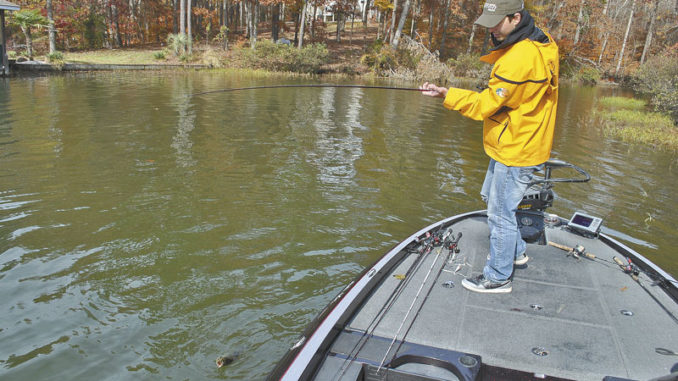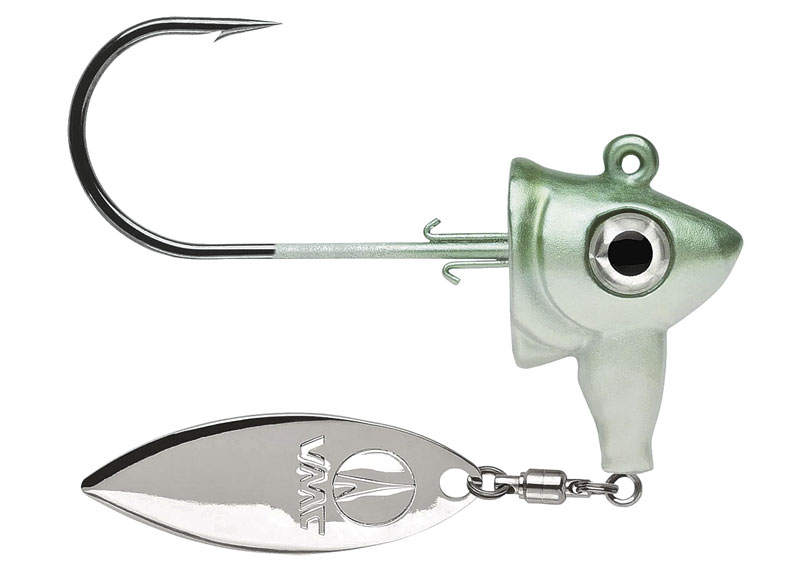

December is a transition month for bass in most of our lakes across the Carolinas, a time when fish are moving out of creeks and back to the main lake, and when they’re following baitfish back out to the deeper water where they’ll spend the winter.
I love to fish topwater in September and October, and even into November, but in December, I move away from that because bass aren’t going to be near the surface nearly as much. But they’re still bait-oriented, so they’ll be around blueback herring, threadfin shad and gizzard shad, the three main baitfish in our lakes. If you keep up with where the baitfish are, you’ll never be too far from bass.
Before we had the great marine electronics we have now, we used to always follow the birds, the seagulls, to find the bait. Our electronics are so good now, you can use them to make sure you’re around bait. When you find it, pay close attention to where it is in the water column. You might find bait 10 feet deep over 30 feet of water, or the bait might be right on the bottom or just off the bottom. It’s very, very important to know where they are in relation to the bottom.

Two-lure attack
When I find bass and bait in this kind of situation, I like to fish a couple of different things. I want to fish a swimbait, a 3- or 4-inch Storm Largo Shad, rigged on a VMC swimbait jig, which has a round head and a screw-lock. It will hold the plastic really well; you’ll used about one-third of the plastics with the screw lock as you would without it. My other bait is a soft-plastic jerkbait, a Yamamoto D Shad. I’ll fish it on a VMC underspin jighead. And you can’t go wrong with pearl or Tennessee shad colors, but I like a little chartreuse this time of year, like a Sexy Shad color, because the water will usually have a little bit of stain.
The size of the jighead you use will depend on how deep the bait is holding. If the bait is still back in a creek, maybe 6 or 8 feet deep, I’ll use a 3/16-ounce head. If the bait is 15 feet deep over 30 feet of water, I’m going to use a 3/8-ounce head, because the bigger size will let you get the bait down to the fish faster.
I like to fish these baits on a 6 1/2- or 7-foot baitcasting outfit spooled with 12-pound Suffix.
Normally, I’m going to fish the underspin when the bait and bass are closer to the bottom; that’s usually later in December when the water is colder. You can make really long casts with it and just crawl it across the bottom. That’s how Casey Ashley won the Bassmaster Classic on Lake Hartwell a few years ago, crawling a swimbait on an underspin through the bass.
The countdown
Now, getting your bait in a bass’s strike zone is much easier than it used to be. The old-school way was to count the bait down a foot per second as it sank. Obviously, a 3/16-ounce jig isn’t going to fall as fast as a 3/8-ounce jig, but that’s all we had. The cool thing is now, our electronics are so good, you can drop a bait down below your transducer and see it on sonars like the Humminbird D2 I use, and electronics have come so far, you can see a 1/4-ounce jig falling. You count while you watch it fall to the depth you want to fish, you figure out the count, and once you see how long it takes to fall, you shouldn’t have to look at the sonar again; you can count it down accurately.
Most of the newer electronics have forward-facing transducers, and you can see 30 or 40 feet in front of your boat. You can cast a jig in front of the boat and watch it fall that way. If you can’t, you can just drop it down under the transducer and count it down.
Usually, when I find the bait and bass suspended, I like to just let the bait fall to the depth I want it and just swim it back through them using a steady retrieve. If that doesn’t work, I’ll use a stop-and-go retrieve, maybe also lifting the bait up with my rod tip. It used to be a bit of a guessing game, but now you know you’re around fish. The big puzzle for so many years was, were you using the right bait, and were you around fish? Now, with our electronics, you can know you’re around fish.

One-day patterns
Normally, when I’m fishing like this, I like colder water. I think it puts the bait closer to the bottom and schooled up tighter. I don’t go looking all around, but if I find a place in the area I’m fishing with water that’s a degree or two colder, that’s what I’m looking for. Fish will stay active until the water temperature drops down into the mid-40s; that’s when I’ll start looking for warmer water. Also, don’t be upset if you don’t kill ’em right off the bat. A lot of times, the better bite may be later in the day, especially if you get a high-pressure day.
The weather also plays a big part in how you change up from day to day. You can pattern bass when you get on them like this. If you find them suspended 15 feet deep over 30 feet of water one day, you’ll find them in different places just like that. But you can’t fish one day and come back the next weekend and find them in the same depth. They will vary from day to day because of the amount of sunlight you get and the barometric pressure, things that affect fish behavior.




Be the first to comment